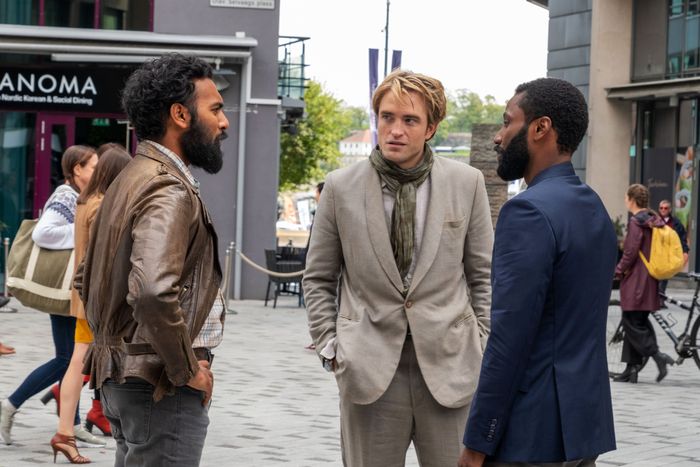
The decision seemed drastic at the time. Rates of COVID-19 cases were only beginning to rise in North America, but a battle against the novel coronavirus was intensifying across the Pacific Ocean. Seventy thousand Chinese movie theaters were forced to close, a major blow to what was then the world’s second-largest movie market. So in March 2020, the producers of No Time to Die decided it was no time to release a movie. MGM Studios, Universal Pictures, and Eon Productions kicked the April 10 release back to Thanksgiving, and the 25th James Bond installment became the first presumed blockbuster to succumb to the global pandemic.
Never mind that just a month earlier, MGM paid an eye-watering $5.69 million for a trailer to air during the Super Bowl. The studio partners behind Daniel Craig’s 007 swan song would go on to spend $66 million marketing the film, including the money spent during the delayed seven months, only to switch release dates again to April 2021. Worse still, MGM was accruing $1 million a month in interest charges on the money it borrowed to finance No Time to Die — cash the company couldn’t recoup until the movie, which cost at least $250 million to produce, arrived in multiplexes. Weeks after its second release switcheroo, S&P Global downgraded MGM’s credit rating from a B+ to a B based on “sustained high leverage as a result of ongoing theatrical delays.”
In January, No Time To Die was bumped a third time to October, forced to linger on a shelf along with other delayed event titles such as Top Gun: Maverick (initially set to release July 12, 2019, it’s now coming out May 27, 2022, after getting delayed six times), Ghostbusters: Afterlife (initially set to release July 10, 2020, it’s now coming out November 19 after getting delayed four times), and Spider-Man: No Way Home (initially set to release July 16, it’s now coming out December 17 after getting delayed twice), waiting for respite from COVID. The concern keeping studio executives awake at night: Can you hold your way to a hit?
MGM and Universal plunked down $175 million in prints-and-advertising costs during the last few weeks of its promotional push. And amid a surge in the Delta variant, the Cary Joji Fukunaga–directed, two-hour-43-minute No Time to Die finally reached overseas theaters October 1, tallying a surprisingly strong $119 million — the first Hollywood tentpole to cross the $100 million mark without playing in China. It has racked up a global “cume” of $454.8 million to date. When the film made North American landfall two weeks ago, it broke franchise records in Thursday previews, eventually pulling in $56 million in 4,400 domestic theaters — slightly underperforming industry expectations for a weekend debut in the $60 million to $70 million range — to become the fourth-biggest opening of a 007 movie ever. (And unlike the previous weekend’s pandemic-best box-office winner, Venom: Let There Be Carnage, Bond exerted most appeal to viewers age 35 and up.) Since October 8, No Time to Die has taken in a shade under $100 million in North America.
That makes No Time to Die the sixth film originally due in theaters last year to have landed with landmark ticket sales over the past seven months. Godzilla vs. Kong stomped off with $48.5 million in April, and A Quiet Place Part II loudly proclaimed a return to theatrical moviegoing with its $57 million bow over Memorial Day. In late June, F9 supercharged the North American box office by taking in $70 million, the biggest opening-weekend tally for any film since Star Wars: The Rise of Skywalker in 2019. And in July, Black Widow grossed $80 million in 4,160 North American theaters ($78 million internationally), a tally not far off the blockbuster openings of MCU megahits Black Panther and Captain Marvel. The takeaway: Hollywood’s tactic of holding its most-premium product until audiences could return to the cinema with a lowered risk of infection seems to be working.
Nonetheless, the wholesale delay of a multitude of blockbusters — Christopher Nolan’s Tenet, Disney’s live-action Mulan, and Venom: Let There Be Carnage moved four times each — has not been without a multitude of hidden costs. According to studio executives, agents, producers, entertainment lawyers, and filmmakers contacted by Vulture, the financial disarray within Hollywood goes deeper than just bringing the theater chains AMC, Cinemark, and Regal to the brink of bankruptcy. (The smaller Alamo Drafthouse chain entered and exited Chapter 11 this year.) Alongside escalations in the streaming wars last year — Disney dumped big movies like Mulan and Soul directly onto Disney+ and WarnerMedia transfered its entire 2021 slate to HBO Max in an unprecedented day-and-date paradigm shift that infuriated the industry — careers up and down the entertainment ecosystem have been disrupted. Financiers and distributors have found themselves with competing agendas as producers look to maximize individual box-office paydays while studios remain focus on the financial health of their overall movie slates. Repayments to banks that loaned studios the “negative cost” of films (the cost of producing and shooting a film up to the point of a completed negative) have been indefinitely put on hold. Vast reservoirs of marketing cash have evaporated as studios have attempted to keep their films fleeing down the release calendar at the front of our collective mind. A cascading logjam of big titles hitting movie theaters from the fall into next year is all but certain to cut into every participant’s bottom line.
No one is entirely sure how to measure the exact dollar amount that has been lost other than to say it’s a gargantuan, multibillion-dollar sum — “massive amounts of money that will never get into the black,” as one studio executive puts it. According to our sources, studios have ways to compartmentalize some of the losses into manageable chunks by, for example, pointing to increases in streaming-service subscriptions. But on the heels of a disastrous 2020, when North American box-office tallies fell by an unprecedented 80 percent year over year, everyone agrees the delays are nothing but bad for business. “Movies aren’t like autographed baseball cards,” the executive adds. “Assets will technically depreciate over time. You can’t just put titles on ice for perpetuity.”
As recently as last month, No Time to Die seemed like it might suffer the consequences of its temporary freeze. The underwhelming opening tallies for movies like The Suicide Squad and the Dwayne Johnson–Emily Blunt two-hander Jungle Cruise were blamed on Delta-era theatergoers’ plummeting comfort levels in theaters, according to a poll by the National Research Group. And that data scared studios into a new round of delays, pushing titles including Clifford the Big Red Dog and Jackass Forever out of September and back by several months. While some Hollywood watchers speculated that No Time to Die’s days on the October-release calendar were numbered, others gave voice to a grim reality — namely, that half-siblings Barbara Broccoli and Michael G. Wilson, the top executives at 007’s longtime production company Eon (which has final say on the film’s distribution strategy), couldn’t afford to hold it any longer. “The Broccolis care about the U.K. more than anything — making it a big hit in the U.K., a decent hit in the U.S. and the rest of the world,” says a person with knowledge of Eon. “But they’ve lost so much money by moving No Time to Die, the marketing has gotten stale.”
In February 2020, Billie Eilish dropped the movie’s slow-burn theme song, “No Time to Die,” which generated 2.2 million YouTube views within six hours and hit the top of the U.K. singles chart). And co-star Ana de Armas graced the cover of the March issue of Vanity Fair — invaluable promotional real estate for which there would be no do-over. Even harder to evaluate is the momentum squandered by disruptions to the film’s numerous branded tie-ins — licensed products intended to draft off the superspy’s historical association with sophistication and luxury while implicitly helping to promote the film outside traditional movie-marketing spheres. Among those tie-ins: the clothing company Orlebar Brown’s 007 Heritage collection, Triumph motorcycles, a cashmere line by N.Peal, 007 x Adidas (featuring a $200 limited-edition colorway of the Ultraboost 20 shoe), Bollinger Champagne’s 007 Cuvee, Omega watches, and a limited-edition 007 Cammegh roulette wheel.
“Branded vendors really had to back up; it’s tough for them,” says Jason E. Squire, the editor of The Movie Business Book and a professor at USC’s School of Cinematic Arts. “Merchandising and consumer-product tie-ins have one of the longest lead times. These deals are made for exclusive rights years in advance. All the tie-ins were paid for but put on hold. The result is a lot of inventory that’s sitting, gathering dust.”
Other costs of holding a blockbuster are less easily quantified. “Talent,” as creatives are called in the industry, are seeing their pay packages kept on a shelf thanks to the rescheduling do-si-do. “A big actor or a big piece of talent was supposed to have received $10 million, $20 million in revenue in March 2020 but doesn’t see that money until December 2021,” an entertainment lawyer who represents a number of successful actors and filmmakers explains. “There is the time value of money.” Moreover, that movie might have been forced to partially or completely forgo a theatrical release and release on demand or via a streaming platform. “You have to compromise in terms of the upside,” the lawyer adds. “You’re thinking it’s going to be this big thing, and you’re going to get all these box-office bonuses and all these residuals. Then boom. It doesn’t happen. It’s going straight to SVOD. So you’re losing that revenue.”
The HBO Max fiasco in particular strained talent relationships and made things financially complicated for Warner Bros. In December, the studio shocked almost everyone in Hollywood when it announced it would release all 17 of its 2021 movies in theaters and on its streaming platform at the same time. Denzel Washington, the lead actor in Warner’s January 2021 detective-thriller The Little Things, had a deal said to include a $20 million fee and back-end payments triggered when the movie sold certain amounts of tickets. According to The Hollywood Reporter, Warner ended up paying Washington the maximum amount of back-end box-office bonuses because the film’s ticket sales were significantly diminished by HBO Max. In the unregulated world of post-pandemic, streaming-era profit participation, it’s difficult to know how to proceed. As former Hollywood Reporter editor Matthew Belloni notes in his What I’m Hearing newsletter, “calculating an accurate backend requires basic transparency in ratings and revenue, which streamers abhor.” He points to Disney’s capricious and previously undisclosed points system called “Serious Bonus Exhibit,” which drastically diminishes the dollar amounts Hollywood creatives earn via video on demand instead of back-end profits. Because Disney does not publicly disclose its Disney+ viewership, there is no way to verify Jungle Cruise took in $30 million via video on demand — and by extension, how much Johnson is truly owed in the studio’s making-it-up-as-it-goes Serious Bonus Exhibit fees. Washington remains just one of a score of directors, writers and stars — Keanu Reeves, Angelina Jolie, Will Smith, and Margot Robbie among them — with Warner Bros. deals in need of renegotiation and transparency.
Then there’s the litigation. In July, Scarlett Johansson became a kind of COVID-era compensation-rights torchbearer when she sued Disney for $80 million in a breach-of-contract lawsuit for releasing her solo-starring vehicle Black Widow on Disney+ concurrent with its theatrical bow. The crux of her argument: The studio bilked her out of back-end bonuses by dumping the the $200 million thriller online after guaranteeing her a “wide theatrical release.” Disney denied any wrongdoing. But after a nasty back-and-forth during which it divulged Johansson’s $20 million up-front payday and called her complaint “sad and distressing in its callous disregard of the COVID-19 pandemic,” the studio settled with her September 30, reportedly paying the star an additional $40 million of the $50 million sources say she expected to make under an ordinary rollout.
According to producers and studio executives, the delay in back-end payments has had an unexpected side effect: Hollywood talent agents are stepping outside their prescribed role as dealmakers for individual clients in an effort to recoup their own losses. Acting as independent intermediaries, they have been attempting to sell studio movies to streaming services — never mind that agents are not authorized to make such deals. “They go around to the streamers and are like, ‘Hey, would you maybe be interested in this movie?’ Even before the studio would talk about it,” says one executive. In era of splashy studio sell-offs — Paramount auctioned off Coming 2 America for a reported $125 million and the Chris Pratt sci-fi actioner The Tomorrow War for a rumored $200 million to Amazon Studios, and Sony sold Seth Rogen’s An American Pickle and the Kristen Stewart vehicle Happiest Season to HBO Max and Hulu, respectively — such extreme agenting is euphemistically understood as “trying to pull forward the cash flow.” “They got paid on the deal that they made when the client got the acting fee 18 months ago,” notes a hit-making producer. “But if the movie doesn’t come out, then that $15 to $20 million of back-end hasn’t come in. That means an agency doesn’t see their 10 percent of that. And they have operating expenses they need to cover.”
He points to the plight of Tom Hanks. Aside from being one of the most famous Hollywood actors to have come down with COVID, he had four film projects with release dates set to bump up against one another during the pandemic. But now two of them, the Apple TV+ sci-fi dramedy Finch and Baz Luhrmann’s Elvis, have been rescheduled. “Some of their clients have four or five movies sitting in inventory that can’t get released in a way that’s beneficial to the client,” the producer continues. “You can’t just dump a movie every other month for six months from the same actor. So they’re trying to be like, ‘Hey, sell it to a streamer. You’ll make a profit.’”
Of course, the postponements have put actors on the opposite end of the fame spectrum into a kind of career limbo, leading to intangible costs Hanks could never understand — namely, lost buzz and “goodwill” that would ordinarily lead newcomers to more jobs. “People don’t know who the person is,” the lawyer continues. “‘Hey, that’s a good young actor.’ And everyone can say, ‘Oh, they’re in that movie.’ But they didn’t get that pop, right? Typically, there’s goodwill from the movie getting made. You don’t have the movie out, so you don’t get the goodwill. It’s more than just money. It’s the profile. You just lost that recognition.”
Although most American cinemas have reopened and audiences are showing surprising gusto for the communal-viewing experience, few industry observers expect box-office records to continue toppling as fast and furiously as they have for the past half-year. That is in part due to the hybrid-release pattern of several of Q4’s biggest impending blockbusters. Crowd-pleasers and awards bait such as Halloween Kills (October 15), Finch (November 5), King Richard (November 19) and The Matrix 4 (December 22) will become available on streaming platforms alongside their theatrical releases, thereby cutting into the films’ box-office returns. Director Denis Villeneuve’s lush sci-fi epic Dune arrives in North American theaters and on HBO Max October 22. Carrying a $165 production budget, it has already been performing solidly overseas (earning $129 million since its mid-September international rollout), but it will likely have to clear between $350 million and $400 million to break even. To hear it from one film financier, the sheer volume of COVID-delayed movies hitting the multiplex in the coming months is of graver concern. The list includes the Spider-Man Cinematic Universe entry Morbius, director Kenneth Branagh’s Agatha Christie adaptation Death on the Nile, the Robert Pattinson–starring reboot The Batman, and Top Gun: Maverick. Such a gridlock is already managing to disrupt the simpatico relationship between producers and studio executives.
“The interest of the studio and the producer-financier are out of alignment,” the financier says. “Because the studio now is like, ‘Oh shit, we’ve got a huge inventory of films, and we don’t have enough time to release them because there’s going to be this flood of big studio movies. What do we want out of our movie? Do we just want to get it off the shelf so that it doesn’t interfere with Spider-Man and Dune? Or do we want to maximize the value of each individual title?’ As a producer-financier, you’re like, I want every penny. If you’re the studio, you’re like, I got the whole slate to look out for.”
When it comes to No Time to Die, the film managed to shoulder its way into theaters before the real glut of movies expected this fall, winter, and spring. Still, according to industry analysts, the Bond film will have to sell between $800 million and $900 million of tickets to be considered a hit — a high hurdle even with the film set to reach China (which recently surpassed North America as the world’s top cinematic market) October 29 and Australia November 11.
When you factor in the $1 million a month MGM has been paying in interest costs, yesteryear’s Super Bowl ad, the tens of millions squandered during No Time To Die’s first postponement, multiple subsequent ad campaigns, the untold costs of holding its branded tie-ins, and the film’s steep 56 percent drop in its second weekend in domestic theaters, a source with knowledge of MGM and Eon’s balance sheet estimates that pandemic-related delay have conservatively cost No Time to Die between $100 million and $200 million in additional unforeseen expenses.
“China and Australia are the two last big pieces of the puzzle,” says Shawn Robbins, chief analyst for BoxOffice Pro. “Spectre did about $85 million in China six years ago. The two of them together could push it closer and closer to the $800 million mark.”
Compare that with Black Widow, which cost more than $200 million to produce. Conventional industry wisdom holds a film’s break-even point to be its production budget times two. That means Black Widow had a $400 million benchmark to meet before taking into account Disney’s multiple promotional spends due to rescheduling. The movie took in $379.3 million globally and another reported (yet impossible to independently verify) $125 million via PVOD rentals on Disney+ for a $504.3 million cumulative gross. In all likelihood, it barely crossed the threshold of profitability, if you believe Disney’s numbers. Studios might be able to hold their way to profitability, but creating a true blockbuster in the pandemic era still feels out of reach.







